BOOK REVIEW: IN TIERS OF GLORY
Title: In Tiers of Glory: The Organic Development of Catholic Church Architecture
Author: Michael S. Rose
Publisher: Aquinas Publishing Ltd.
Reviewer: Francis X. Altiere
Summary: In Tiers of Glory is the perfect primer for those who would like to know about church architecture. With 11 chapters and a handy appendix, Michael Rose covers each architectural period in history with plenty of information and pictures. From Old Testament precedents to the restoration of traditional forms of architecture today, this book fills in many of the blanks too often present with such a topic.
As he washes his hands before consecrating the sacred host, the priest repeats the words of King David and makes them his own: "I have loved, O Lord, the beauty of Thy house and the place where Thy glory dwelleth." In a memorable passage, the late Professor John Senior explained:
Western Civilization is the Mass and the paraphernalia which protect and facilitate it. All architecture, art, political and social forms, economics, the way people live and feel and think, music, literature–all these things when they are right, are ways of fostering and protecting the Holy Sacrifice of the Mass. To enact a sacrifice, there must be an altar, an altar has to have a roof over it in case it rains; to reserve the Blessed Sacrament, we build a little House of Gold and over it a Tower of Ivory with a bell and a garden round about it.1
If the state of Christian architecture is so intimately associated with the sacred liturgy, we should not be surprised to have entered a period in which the fate of ecclesiastical building is in question during these days of post-Vatican II liturgical anarchy. To be sure, it is not merely a case of post hoc ergo propter hoc:2 Le Corbusier's iconic modernist chapel at Ronohamp, for example, was built in 1956. But, as Michael S. Rose notes, "new theories of architecture, theology, and liturgy (inspired by both Protestantism and Agnosticism) increasingly affected the Catholic Church through the course of the 20th century," and the relationship between theology, liturgy, and architecture cannot be discounted. Though not intended primarily as a polemical work, Rose's valuable new book In Tiers of Glory: The Organic Development of Catholic Church Architecture Through the Ages outlines the standards of sound Christian architecture and points out the modernist errors that have marred ecclesiastical buildings in the last 50 years. Mr. Rose convincingly argues that differences in style-whether late antique basilican, Byzantine, Romanesque, Gothic, Renaissance, Baroque, or the various "neos" of the 18th and 19th centuries–are ultimately of less importance than the underlying coherence of architectural principles that have typified Catholic churches through the ages. Only in the 20th century, and at an accelerated rate after the Second Vatican Council, have these principles been neglected.
Mr. Rose, who holds degrees in architecture and fine arts from the University of Cincinnati and Brown respectively, is no stranger to the fray. He has already penned two other books lamenting the crisis in church architecture, and his articles criticizing, inter alia, the "Jubilee Church" in Rome and the proposed modernist chapel for Ave Maria University pull no punches. In Tiers of Glory does not hesitate to couch a rather bold–though, as it turns out, undeniable–assertion in its rather innocuous prose: for over 1500 years Catholic churches organically reflected changing architectural taste, always in subordination to the needs of the liturgy and Catholic devotion, but in the past half century there has been a rupture with this tradition. In Tiers of Glory is neither a theoretical treatise nor even a detailed history, although in reading through the brief sections on each of the major phases of ecclesiastical style (the average chapter is only eight or so pages long), one may occasionally want a deeper explanation. To compare Italian and Iberian baroque in the space of a few sentences–and scarcely to mention the variations of Eastern European baroque–would be inexcusable in a larger study. Here, however, the author is constrained by the nature of his project. As it is, Mr. Rose does succeed in a small space in explaining, among other things, how the bulky Romanesque churches of the Carolingian period turned into the lightflooded Gothic shrines of the 13th century and why various revivalist schemes of the 19th century do not always reflect the originality of their antecedents. In each chapter Mr. Rose summarizes the particular genius of each of the principal phases of Christian architecture; thus, for example, the churches of the Renaissance are marked by "simplicity, order, and harmony," whilst the Gothic is marked by a "vigorous vertically." Mr. Rose's book can best be described as a didactic historical and artistic survey. That is, his explanation of the harmonious development of church architecture is ultimately ordered to inviting the inevitable question on the part of the reader: why are modern churches so ugly and how can we recover a sense of the sacred?
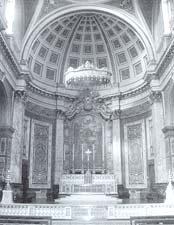 |
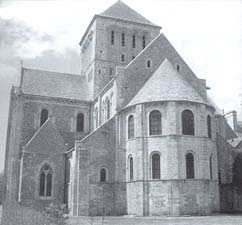 |
|
|
Brompton Oratory, London |
Lessay Abbey, France |
In Tiers of Glory manages to evaluate not only the physical "evidence" of Catholic churches of the last 18 centuries, but also provides contextualizing historical sketches admirable for their clarity and brevity, and draws as well on wide-ranging sources–such as the Spiritual Exercises of St. Ignatius and the testimony of the 12th-century Abbot Suger. The reader will also be introduced to some of the most important Catholic architects of all time–giants like Brunelleschi and Borromini.
A few words are in order about the arrangement and appearance of the book itself. In Tiers of Glory is a luxuriously illustrated durable softcover. The book's 11 chapters cover topics from the Old Testament antecedents of Catholic architecture to the present-day revival of sacred architecture; in each chapter the reader will find illustrative color photographs and drawings–although he may wish that the penultimate chapter, on what Rose calls "Breaking with the Past," had remained blank! Marginal notes summarize the most important points, and an expansive glossary of terms ensures that the lay reader will not confuse his pilasters and his buttresses. By the author's own account, In Tiers of Glory does not "intend to consider the nuances and theories of many venerable architecture historians of ages past and present." Even though an informed reader will want to know, for example, what Rose makes of Pugin's medievalist ideology or Wittkower's theory of the relation between music and Renaissance architecture, the book is more valuable as an introduction to the genius of traditional architecture for those who may feel deep down that there is something wrong with modern churches but cannot articulate what it is exactly.
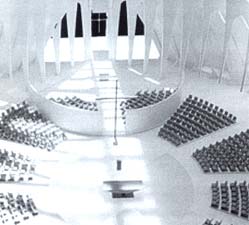 |
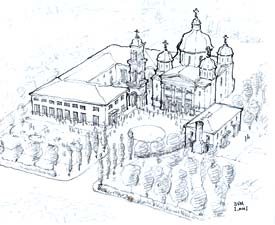 |
|
|
Oakland Cathedral, California |
Design proposal for Ukranian Catholic Church in New Jersey. |
In Tiers of Glory is more than just an attractive introduction to sacred architecture; it is, in a sense, a rallying cry. The author rallies theoretical, anecdotal, and photographic examples to validate the underlying thesis of the work:
No successful architect can be... ignorant of the Church's historical patrimony. Continuity demands that a successful church design cannot spring from the whims of man or the fashion of the day. A successful Catholic church building is a work of art that acknowledges the previous greatness of the Church's architectural patrimony: it refers to the past, serves the present, and informs the future.
The most encouraging section of In Tiers of Glory is the final chapter ("The Wisdom of Hindsight"), on the revival of traditional architecture in our own day. Here Mr. Rose highlights some of the most promising architectural "traditionalists" (his term) of today. Although he is careful to note the symbiosis, or rather parasitism, between architectural and liturgical modernism, and bemoans early aberrations in the Liturgical Movement, Mr. Rose does not offer specific critiques of the liturgical reform carried out after the Council. If the New Mass, however, is, as even the Holy Father has admitted, a "banal on-the-spot product," then the vulgarity of the churches it has inspired ought not to surprise us. It is possible that specific criticisms would be out of place in a survey like In Tiers of Glory and indeed the absence of such a critique does not undermine the value of what is a beautiful, considerate and yet accessible book.
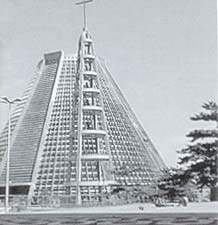 |
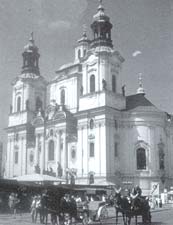 |
|
|
Sao Sebastiao Cathedral, |
St. Nikolas Chruch, Prague |
Francis Altiere is currently an M.Phil. candidate in architectural history at the University of Cambridge. He received his bachelor's degree in history from Harvard University in 2004. This article was commissioned by Angelus Press.
1. Restoration of Christian Culture, pp. 15-16.
2. Literally, "after which, therefore because of which." A kind of logical fallacy which asserts that because an effect is after a cause in time, the effect is necessarily because of the prior cause.
